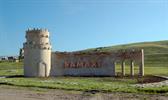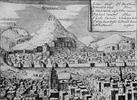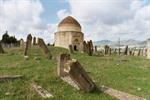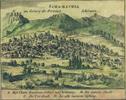Shamakha, for so long the capital and trade centre of north-western Azerbaijan, is now a surprisingly small town with little to show for its historical prowess. The distinctive double hill around which the old town was dramatically set is still there, but the remains of the impenetrable Gulustan Castle have finally been defeated by time and are quietly crumbling into memories along with the scars of endless invaders and earthquakes. The low-rise homes are pleasant enough when viewed from Yeddi Gumbaz mausoleum across the valley, but the grand central mosque is the only architectural attraction in the town itself.
The city has a rich heritage and has provided the backdrop to major political events throughout much of its two millennia of existence. For centuries, Shamaxa (Shemakha) was one of (northern) Azerbaijan's most prominent cities, an important cultural and trading centre and the royal seat of the Shirvanshahs (9th to 18th centuries).
In its history eleven major earthquakes have rocked Shamakhi, but through multiple reconstructions it maintained its role as the economic and administrative capital of Shirvan and one of the key towns on the Silk Road. The only building to have survived eight of the eleven earthquakes is the landmark Juma Mosque, built in the 10th century.
Apart from that, earthquakes, fire and invasions have left virtually nothing visible to remind the visitor of Shemakha's past importance. In the Soviet era the surrounding hills produced famous wines and cognacs but that industry was decimated by Gorbachev's anti-alcohol campaign and has never fully recovered. These days the town is best seen as a staging point for reaching Pirqulu rather than as a destination in itself.
The city's estimated population as of 2010 was 31,704. It is famous for its traditional dancers, the Shamakhi Dancers.
History
Shamakhi was first mentioned as Kamachia by the ancient Greco-Roman Egyptian geographer Claudius Ptolemaeus in the 1st to 2nd century.
Shamakhi was an important town during the Middle Ages and served as a capital of the Shirvanshah state in 8-15 century and the capital of the independent Shirvan Khanate, which was also known as the khanate of Shemakha. The Catholic friar, missionary and explorer William of Ruysbroeck passed through it on his return journey from the Mongol Great Khan's court.
In the middle of the 16th century it was the seat of an English commercial factory, under the traveler Anthony Jenkinson, who was afterward the envoy extraordinary of the Persian Shah to Tsar Ivan IV the Terrible of Russia.
Adam Olearius, who visited Shamakhi in 1636, wrote that the population of the city consisted of Persians, Armenians and some Georgians, and while they all had their own languages, they spoke a Turkish language, like the people of Shirvan in general. In the 1720s, the population of Shemakhi was about 60,000, most of whom were Armenians and strangers. In 1742 Shamakhy was taken and destroyed by Nadir Shah of Persia, who punished the inhabitants for their disobedience and Sunnite creed by building a new town under the same name about 16 miles (26 km) to the west, at the foot of the main chain of the Caucasus Mountains. The new Shemakha was at different times a residence of the Shirvan Khanate, but it was finally abandoned, and the old town rebuilt. The Russians first entered Shirvan in 1723, but soon retired leaving it to Ottomans who possessed it in 1723-35. Shirvan Khanate was finally annexed by Russia in 1805.
The British Penny Cyclopaedia published in 1833 stated that "The bulk of the population of Shirvan consists of the Tahtar, or, to speak more correctly, Turkish race, with me admixture of Arabs and Persians. Besides the Muslims, who form the mass of the population, there are many Armenians, some Jews, and a few Gipsies. According to the official returns of 1831, the number of males belonging to the Muslim population was 62.934; Armenians, 6,375; Jews, 332; total males 69,641." The same source also states that according to the official returns of 1831, the city was inhabited by only 2233 families, as result of devastation during the wars. According to Brockhaus and Efron Encyclopedic Dictionary, Shamakhi had 20,008 inhabitants (10,450 males and 9558 females); of them Azerbaijanis 79%, Armenians 18%, and Russians 3%.
Until the devastating earthquake of 1859, Shamakhi was the capital of the Shamakhi Governorate of the Russian Empire. From 1859, when the capital of the province was transferred to Baku, the importance of the city declined.
Earthquakes
- The 1191 earthquake was so destructive that the capital of Shirvan was transferred to Baku.
- The 1667 earthquake is considered to have been the worst with a death toll of 80,000; one-third of the city collapsed, according to the Persian merchants' reports.
- The December 2, 1859 earthquake caused the shifting of the same-named government center to Baku.
- In 1902, a devastating earthquake destroyed the 10-century Juma Mosque.
Orientation & Information
The bus station commands a roundabout on the Baku highway, southeast of the town centre. From here Shirvani str slopes uphill into town passing the Juma Mosque, behind the usually closed tourist information booth on the left after 1km. After another kilometre the road starts to curve uphill much more sharply, reaching the centre after around 800m at a colourfully mosaic-muralled theatre. Straight ahead is Narimanov str leading towards Pirqulu; to the right Shahriyar str passes within a block of the Hotel Shemaxa, an Internet Klub and the post office.









